Disability Influencer launches world’s first truly accessible retail site

One of the UKs most prominent disability influencers has announced the launch of a fully accessible retail site which he says could unlock a £17bn spending opportunity for retailers. Mike Adams OBE has initially launched EnableAll.com with a host of independent retailers with the aim of making it the world’s first truly accessible marketplace. EnableAll.com says billions of pounds is being lost by retailers who don’t meet the needs of disabled people when it comes to online purchasing and suggests major retailers need to think hard about their commitments to the disability community. He said: “With EnableAll.com, we’ve created a very straightforward platform that puts inclusivity and accessibility front and centre and allows any retailer trading online the opportunity to trade simply with the 14.6m people with disabilities in the UK, many of whom find it impossible to complete everyday tasks such as buying products online because e-commerce sites create barriers to accessibility that do not need to exist. “We’re still very early on in our journey, but why wouldn’t a retailer want to gain access to this scale of marketplace? The retail industry has to ask itself in 2023 why there is a need for such a platform.” Mike has been listed in the UK Power List 100 of the most influential disabled people and explained how the idea for EnableAll.com came about during the Covid pandemic when high street and retail stores closed, with vast numbers having to rely on online retail. Mike, who is also the CEO of Purple Tuesday, an organisation changing the disability conversation with businesses and disabled people, first introduced the concept on EnableAll.com to the world at the Dubai Expo in 2021, having seen that buying patterns online would leave people with disabilities feeling even further isolated. The site has been meticulously built in that time to follow strict AAA standards, the highest possible conformance level in Web Content Accessibility Guidelines (WCAG). The long-term plan is for EnableAll.com to become the global go-to site for truly accessible e-commerce. The launch of the site has won the backing from a growing number of independent retailers across homes, gardens, pets, clothing, shoes, toys, games, jewellery and accessories. Its straightforward ‘plug and play’ set up for retailers means they can be trading on the site in days and EnableAll.com is now working closely with a number of high-profile high-street brands on developing their presence on the site. EnableAll.com has installed experienced digital retail specialist Kevin Cooper as its managing director. He said: “This site is not only for those people who share a frustration in feeling excluded from everyday experiences that able-bodied people can undertake without a moment’s notice, but also for those many millions who are either carers or are supporters of having an equitable, inclusive and accessible society for everyone. “It’s time for influential people in retail to realise the opportunity here of not only doing the right thing, but opening up an enormous untapped commercial opportunity for a set of willing consumers who are ready and willing to spend what we estimate to be a market worth £17bn annually in the UK alone. Retailers have the opportunity to drive the quality of the online experience for disabled customers.” The site is rapidly gaining support from a host of other influential bodies and individuals, including the likes of Shani Dhanda, a celebrated disability inclusion specialist, broadcaster and entrepreneur. Shani said: “There has been a long-term combination of perception, awareness, and priorities that have held back progress in making online shopping fully accessible. “One big reason is that many see it as a massive and complicated problem to tackle. Making online shopping accessible requires a lot of effort, resources, and collaboration from different players in the industry, but EnableAll.com has created a platform that now offers no reason why major retailers shouldn’t and can’t engage positively.” EnableAll.com is working with charities to partner with that will allow users to select where EnableAll donates 10% of its revenue.
Abacus Academy vehicles to be showcased at OT Show

Abacus Specialist Bathroom Solutions, a leading manufacturer of specialist care baths, will be highlighting its fleet of educational vehicles at the Occupational Therapy Show (Stand F25, NEC, 22–23 November 2023). Multi-award-winning Abacus is a proven choice for inclusive bathing solutions for bathers with disabilities. Its range of power assisted baths provide better outcomes for clients and their families in terms of safety, comfort and occupation. Abacus Regional Assessment Managers work closely with occupational therapists (OTs) and families so that the most appropriate bathroom equipment is provided every time. This relationship is enhanced by an assessment-led approach and the availability of Abacus demonstration vehicles across the UK. With a range of baths onboard, potential users, relatives and supporting healthcare professionals, can physically test equipment in an enclosed, controlled environment. Eliminating the need for difficult, weather dependent demonstrations outside, Abacus provides the professional choice for clear clinical reasoning. Alongside convenient client assessments, these vehicles provide ideal training environments for OTs. In association with the Abacus Academy, the educational programme run by the manufacturer, these vehicles regularly host CPD ‘lunch n learn’ workshops. Abacus Regional Assessment Managers and associates from the OT Service offer unique insight into assisted bathing from a practical and theoretical point of view. Attendees are able to experience a range of baths onboard whilst exploring various postural supports and therapeutic features. Jane Reid, Occupational Therapist, uses Abacus for her client bathing assessments: “I have found assessments with an Abacus demonstration vehicle to be very successful. Clients are able to see and feel the bath equipment in a safe environment. Some of my ambulant clients and their family members have experienced sitting in the baths during the demo, which makes the assessment much more interactive for them. The vehicle provides shelter from the elements and also allows privacy during the assessment.” As the baths are powered in the vehicle there is no need for products to be transferred into a demonstration space – meaning sessions can be easily and efficiently held in car parks. Abacus educational events can be hosted anywhere in the UK and continue to grow in popularity. They are free of charge and count towards CPD hours with certificates and reflective logs available.
Prism Healthcare to Showcase Group Healthcare Innovations at the Occupational Therapy Show
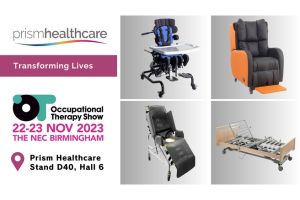
Prism Healthcare (PHC), a leading provider dedicated to transforming lives in the home, long-term care and paediatric sectors, is proud to be exhibiting at the Occupational Therapy Show this week. Prism Healthcare will be showcasing a diverse range of life-transforming products from its group brands: Prism Medical, Harvest Healthcare, Repose Furniture and Smirthwaite. As 2023’s must attend event for all Occupational Therapists (OTs), the renown show takes place from 22 – 23 November at The NEC, Birmingham. As a collection of companies, Prism Healthcare will be showcasing its comprehensive and innovative range of products and services designed to enhance care quality, improve well-being, and ultimately transform lives. Visitors to the Prism Healthcare stand (D40, Hall 6) can explore various solutions for safe patient handling, pressure area care, paediatric care, premium speciality seating and more. Prism UK will be presenting its new Freeway Flow shower cradle, which provides maximum comfort and support during showering. Smirthwaite will be unveiling its bespoke Asiento chair; designed to improve postural support and symmetry. Harvest Healthcare will be introducing its new state-of-the-art pressure care solution, AirSet cushion, which combines the benefits of foam and air to provide optimal pressure relief. Repose will be showcasing its Boston portering chair, and its smaller counterpart, the Boston Junior. Both are extremely comfortable with independent movement of the tilt in space, backrest recline and leg rest elevation functions, enabling a range of postural positions. Prism Healthcare Chief Executive, Jason Leek, commented: “We are proud to exhibit at the OT Show for the first time as a Group and to showcase our exceptional product range. Collaboration is a very important ethos in the Group. “I feel privileged to be able to help build on Prism’s strong legacy of providing products that enhance independence, comfort, and overall well-being in different care environments. I am excited to be leading the Prism business into the next stage of growth and development, continuing our desire to build partnerships and offer solutions for our customers.” Practising independent Occupational Therapist and owner of Athena Handling Ltd, John Callas, will be holding a series of informative workshops and clinics on behalf of Prism Healthcare (link). John passionately champions the cause of OT professionals, propelling them to new heights and pushing the boundaries of what is possible in the world of occupational therapy. Lee Reeves, Group Development Director at Prism Healthcare, said: “Group collaboration is key; our mission is to impact positively the lives of individuals with diverse needs, and this event provides an ideal platform to connect with people who can make a difference with our life-enhancing solutions. We fully understand healthcare professionals’ challenges and strive to give them the tools they need to deliver exceptional care. Prism aims to make it easy for caregivers to provide excellent care, promote learning, aid movement or recovery, and support independence.”
Oscar qualifying short film, Headspace: The struggles of a young man with Down Syndrome
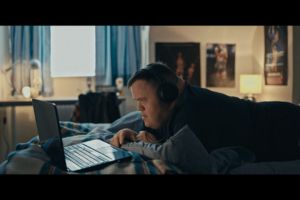
Director Aisling Byrne’s HEADSPACE takes us on a journey with a young man, Tony, who has Down’s Syndrome and struggles to find paid work, causing him to be faced with a moral dilemma whilst staying at a community home. This phenomenal film has qualified to be considered for a 2024 Academy® Award after winning the OSCAR® qualifying award at Cork Film Festival. As the tensions and frustrations of life in a community house start to close in on him, a young man with Down Syndrome realises he may have to cross a line to end a nightly disturbance. Writer and director Aisling Byrne is an award-winning theatre director, screenwriter and filmmaker. Her narrative short debut HEADSPACE premiered at Cork International Film Festival, and won the Oscar Qualifying Grand Prix Best Short. Aisling is the founder and Artistic Director at Run of the Mill, an award-winning arts organisation at the forefront of inclusive arts practice in Ireland supporting learning disabled artists and performers. Their recent work includes a 9 venue National Tour of the award winning MAKING A MARK and the All Abilities Casting initiative in collaboration with the National Talent Academy aimed at levelling the playing field for people with intellectual disabilities in film and tv. Aisling was selected to represent Ireland at the Screen Talent Europe/ Cinesud’s Directors Village 2023. Her narrative short debut HEADSPACE has been selected for the Prestigious European Film Awards and qualified to be considered for a 2024 Oscar®. She continues to work alongside Killian Coyle on the Screen Ireland Focus Short Award recipient short film TURNAROUND, set to film in April 2024. Producer Killian Coyle is a creative producer working alongside theatre and filmmakers between Ireland and the UK with a focus on socially engaged storytelling. He has worked on a diverse range of projects, from film and site-specific performances to national and international tours, and artist development programs; some of the notable highlights of his career include GOOD SEX, MAKING A MARK and HEADSPACE. Killian is continuing to work alongside Aisling Byrne on the development of various TV and film projects including the recently Screen Ireland Focus Short Award recipient short film TURNAROUND, which is due to film in April 2024. The stunning cinematography was created by award winning filmmaker and video designer Kilian Waters. This authentically cast, heartwarming short has qualified to be considered for a 2024 Academy® Award. Upcoming Festivals Kerry International Film Festival (22 October) Past Festivals Boyne Valley International FF – Runner Up Best Short Film Catalyst International Film Festival – Jury Special Mention Flickers Rhode Island FF New Hampshire FF Cork International FF Vancouver Women in Film Manchester Film Festival Fastnet Film Festival International Short Film Festival of Cyprus Louth International Film Festival Disappear Here Film Festival
Beach Wheelchair scheme improves access for all
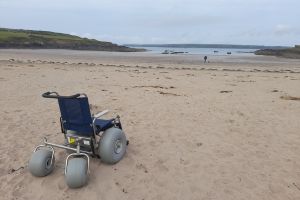
A popular beach wheelchair scheme providing year-round access to some of the most breathtaking beaches along the Pembrokeshire Coast is empowering more locals and visitors to explore this magnificent coastline than ever before. The Beach Wheelchair scheme is run by the Pembrokeshire Coast National Park Authority with funding support from the Welsh Government and Visit Wales’s Brilliant Basics Fund. Feedback from users has been hugely positive: “My husband has recently become disabled, it’s been a traumatic time for the whole family, having the wheelchair helped enormously, he could be part of our trip to the beach which was so vital and important. It was truly life changing.” “Your wheelchair was amazing and made our holiday! My son was able to play with his dog in the sea for the first time ever just like everyone else!!” The wheelchairs are hosted by local businesses around the Park, such as seaside cafes and activity providers. Available in a variety of sizes and styles, the wheelchairs are designed for users young and old, some of whom may use a wheelchair frequently or those who may find it hard to walk on sandy beaches. Other resources include roll-out trackways, all-terrain rollators and a mobile hoist. Individuals bringing their own equipment accessories, such as harnesses, are advised to contact the project coordinator first to discuss fitting and compatibility. We also ask users to read individual chair/equipment instructions before booking, to ensure a fun and safe experience. Avoid disappointment by booking in advance at https://beachwheelchairs.simplybook.it/v2/#book. Further information: www.pembrokeshirecoast.wales/access-for-all. Specific enquiries: beachwheelchairs@pembrokeshire.org.uk.
Swansway Motor Group on the Motability Scheme
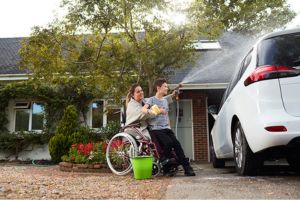
Leah Pitt, Motability Accredited Dealership Marketing Executive at Swansway Motor Group; “The Motability Scheme is a great way for those who are in receipt of a Mobility Allowance to lease a brand-new vehicle, with the cost of everything except fuel covered. There are 5 types of Mobility Allowances, these are as follows – Personal Independence Payment (PIP) – Higher Rate Mobility Component of Disability Living Allowance (HRMC DLA) – Enhanced Rate Mobility Component of Personal Independence Payment (ERMC PIP) – War Pensioners’ Mobility Supplement (WPMS) – Armed Forces Independence Payment (AFIP) Someone who is looking to join the Motability Scheme can start by finding a participating retailer, there are plenty of makes and models available on the scheme and participating car dealerships across the country will have Motability Specialists to help guide you in your decision. Each quarter, the vehicles available can differ, so speaking with a Motability Specialist will help you to further understand what’s on the scheme at the point of your enquiry. Each Motability driver can add up to three drivers to their vehicle, to allow their family, friend, or carer to also drive the vehicle. Adaptations can also be made to the vehicles at no extra cost, to help suit an individual’s needs. On the Motability Scheme, you will receive a brand-new car every three years and the worry-free package from Motability also includes: – Insurance – Breakdown Cover – Servicing, maintenance, and repairs – Road Tax – Window and Windscreen repar/replacement – Up to 60,000 milage allowance over 3 years (100,00 milage allowance over 5 years for WAV’s) You can find out more about the vehicles available on the Swansway Motability Scheme, from the Swansway Motor Group on their website Swansway.
Trekinetic expand UK dealer network
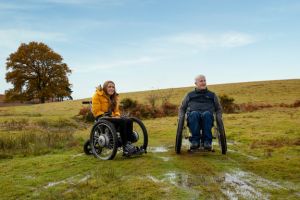
Trekinetic, the leading manufacturer of all-terrain wheelchairs, is excited to announce the expansion of its dealer network in the UK with the addition of postural seating specialists, Consolor. Based in Southampton, Consolor provides posture, seating and mobility assessment services to NHS wheelchair services and private clients across the UK. The addition of Consolor to Trekinetic’s dealer network will improve its ability to support customers in the South and provide a one-stop shop for customers with more complex seating requirements. “We are thrilled to welcome Consolor to our dealer network,” said Ed Spindle, Commercial Director of Trekinetic. “Consolor’s expertise in moulded wheelchair seating provides another dimension for our products and we look forward to working with them to broaden the accessibility of our wheelchairs to an even wider audience“. “Consolor is absolutely delighted to be chosen as a dealer for Trekinetic, as will all the clients whom we serve and support on a daily basis”, said Simon Keeling, Director at Consolor. “Our ability to enhance the daily lives of our clients through optimised postural solutions, regularly empowers each onto a new journey of discovery, one that is often only limited by the boundaries of accessibility. Trekinetic’s successful mission to challenge these boundaries through thought-provoking design and enhanced function sits seamlessly alongside our own ideals, and together we look forward to making the impossible, possible.” The expansion of Trekinetic’s dealer network is a part of the company’s ongoing commitment to providing customers with the best possible local support. By partnering with companies like Consolor, Trekinetic is able to bring its innovative range of all-terrain wheelchairs to a wider audience, helping to improve the quality of life for people with disabilities around the world. For more information about Trekinetic’s range of all-terrain wheelchairs, please visit their website at www.trekinetic.com.
Twitter update is a blow to accessibility, and disabled people will suffer
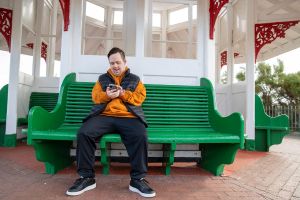
Links to news stories were previously clearly displayed on X, formerly known as Twitter, with headlines, and could be read using screen reader technology. However, in a new update to the platform, links are now shown as a normal picture, and the name of the website, written in small text in the corner, is the only clue that the image contains a link. This means people using screen readers won’t know what the link is until they click it and open it. Disability charity Sense believes the new update will make it much more difficult for people using screen readers to engage with tweets and use social media. Any exclusion of disabled people from social media is a huge concern – the charity’s recent research into loneliness found over half of people with complex disabilities (53%) felt lonely, compared to 25% of the general public. Please see below a comment from Steven Morris, who works for Sense and is himself deafblind and a social media user, sharing his concerns about how these changes will affect him and the many other disabled people who use social media. Steven Morris, Campaigns Officer at Sense, said: “This change is yet another example of accessibility not being considered, and once again it’s disabled people that will suffer because of this. “Disabled people should not be left out of life, but this change will make it far more difficult for some disabled people to use social media, where they could meet people, make new friends and engage in conversations. We know that disabled people are more likely to be lonely than the general population – we should be making social media more accessible, not less. “It’s also more difficult to flag issues like this to the social media platform. We’d urge the management at X/Twitter to reconsider this change, to show they are willing to work towards creating a platform that is accessible to all.” Image courtesy of Adobe Stock.
Smirthwaite Sales Team Strengthened with Jodie Carter Appointment

Smirthwaite, a respected designer and manufacturer of bespoke equipment for children and young adults with additional needs has extended its sales team with the appointment of Jodie Carter who will be taking on the role of Technical Product Advisor, North East & Cumbria/Lancaster. Jodie’s background involves working closely with children and adults with disabilities, including brain injuries. Most recently Jodie has been assessing and installing technology in people’s homes across North Yorkshire to aid vulnerable people, including those with epilepsy or dementia. Reporting to Ewan McPhee, Northern Sales Manager, Jodie will manage her own territory whilst working alongside healthcare professionals to support children with disabilities with bespoke Smirthwaite equipment that promotes a healthier and better quality life for the user. Jodie’s appointment is another exciting opportunity to further strengthen the team at Smirthwaite and include the promotions of Derek York to UK Commercial Manager and Ewan McPhee to Northern Sales Manager. The new appointment and promotions are part of the company’s continued focus on growing its business, investing in its people and delivering excellence for its customers. Jodie commented: “I am delighted to be joining a market leader in the paediatrics industry & a company that’s renowned for quality products and service. I’m very much looking forward to working with our Occupational Therapists and helping to further the growth of the business.” Ewan McPhee, Northern Sales Manager added: “I am thrilled to welcome Jodie to the Smirthwaite team. I’m confident that her excellent interpersonal skills and sheer enthusiasm will help grow market share and help drive our growth plans; strengthening our position in the market moving forward. Jodie also joins us at an incredibly exciting time as we continue to launch new products such as our Asiento postural support chair, Levitex pressure care relief technology & our Moving & Handling equipment. We wish her a very warm welcome.” Smirthwaite are proud of their dedicated, high-calibre staff; and offer competitive pay and rewards, training, career paths, and the opportunity to progress and achieve. Jodie’s contact details: Email: Jodie.carter@smirthwaite.co.uk For further information about UK TPA roles at Smirthwaite, please contact Derek York, Commercial Manager on derekyork@smirthwaite.co.uk or +44 (0)7971126877.